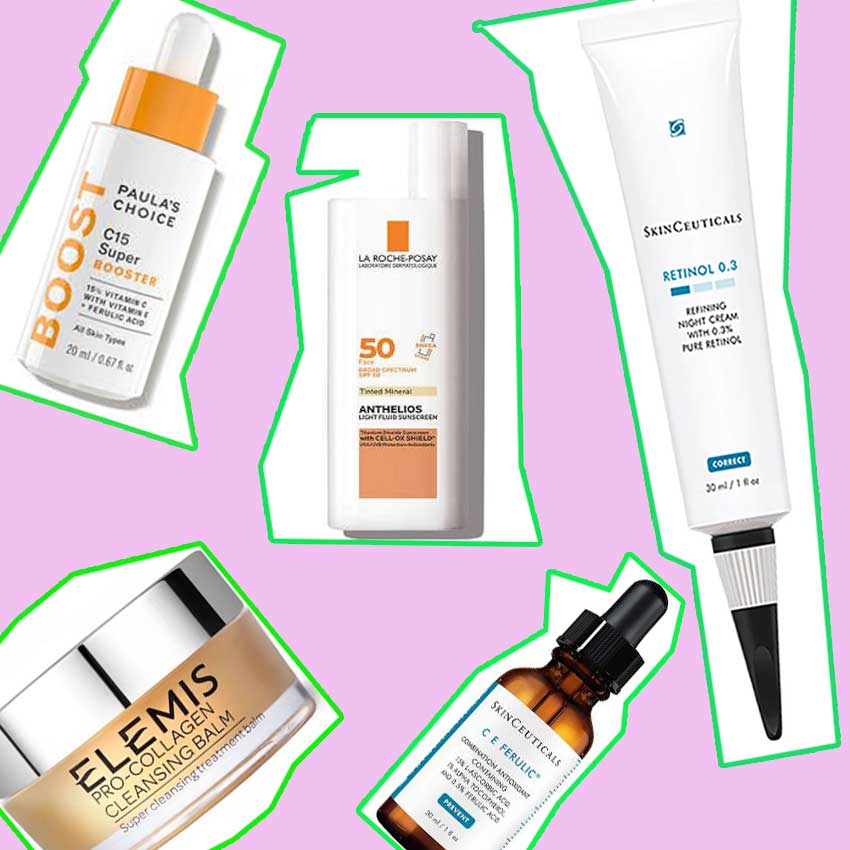How to Create the Perfect Skincare Routine

Skincare is a very personal experience and having a 9-step routine or a 2-step routine is completely up to you. If you like rubbing stuff on your face, by all means have a super long skincare routine, if not, that’s okay too. And if you don’t have a skincare routine at all, or before you dive in and spend hundreds of dollars on this cream or that serum, ask yourself these questions: Why are you buying it? What is your intention? What results you want? And does something else in your routine already cover it?
I am not here to tell you what to do, I am here to tell you not stress out about a skincare routine and do what’s best for you. Because the bottom line is, a skincare routine is a combination of four steps: clean, boost with actives, moisturize, and protect. The only must-do step is protect. The rest is up to you.
Clean
It’s pretty simple: clean your face at night, especially if you have worn makeup. No need for double cleaning, scrubbing or exfoliation. A simple gentle cleanser or balm would do. If I have makeup on, I’ll remove it with micellar water first and then clean with a cleanser, but that’s the extend of it. And you don’t need to clean your face with a cleanser at night and in the morning. I only wash my face with water in the morning and that is sufficient enough. Below are four tried and tested cleansers.

Boost
Actives (aka the ingredient in a product addressing whatever skin concern it’s meant to target) like retinol, vitamin C, AHAs, and BHAs, are necessary if your intention is to boost your skin and address a certain problem. Retinol is anti-aging, Vitamin C is brightening, AHAs and BHAs are exfoliating. But if you are not into it, you can skip this step all together. I personally love actives and have tried all of them, hence my recommendations below. If you are in your 30s, 40s and beyond, actives only benefit your skin. A word of advice for those new to actives: Start slow and at a lower dosage. For example, if you want to try retinol don’t just start with a 1% solution. This stuff is potent and can burn your skin. Instead, start with 0.1% and build your way up. This La Roche-Posay is excellent.

Moisturize
Moisturizing is an important step to keep your skin soft and well hydrated, and there is a ton of information out there on different moisturizers. All you really need to know is what skin type you have and what season you are in (heavier moisturizers in the winter, lighter in the summer) If you live in the Northern Hemisphere, you know winter is currently in full force, and cold air sucks the life out of our skin. That is why in the winter I create a moisture sandwich on my skin – damp my skin with water or essence, add an active, a heavy moisturizer and SPF, and seal it all with a face oil or petroleum jelly. The oil and/or jelly trap all the good, hydrating ingredients of your creams and do not let them evaporate. This trick has been a complete game changer for my skin during the winter.

Protect
This is the only step you cannot skip. Slathering SPF is crucial in preventing skin cancer and preventing premature aging. And here’s the kicker: You need to wear SPF even if you are indoors and especially if you are spending time next to windows, because yes, UV rays get inside too. As you probably know UV stands for ultraviolet, and there are two types of them, UVA and UVB. UVA rays sink deep into the skin and are responsible for dark spots, fine lines, uneven skin tone and wrinkles. UVA rays can pass through window glass. An easy way to remember what UVA means is A = Aging. So, UVAging. UVB rays, on the other hand, are better known for causing sunburn. These rays skim the surface of your skin and leave behind an uncomfortable sunburn. An easy way to remember what UVB means is B = Burn. So, UVBurn. You need a face protector that combats both.

So, does the perfect skincare routine exist? Yes, if you create it by yourself for yourself.
Anna Marevska is the Editor of FashionFiles. She is responsible for the overall editorial direction of the site and writes runway stories, designer profiles, and trend reports.

